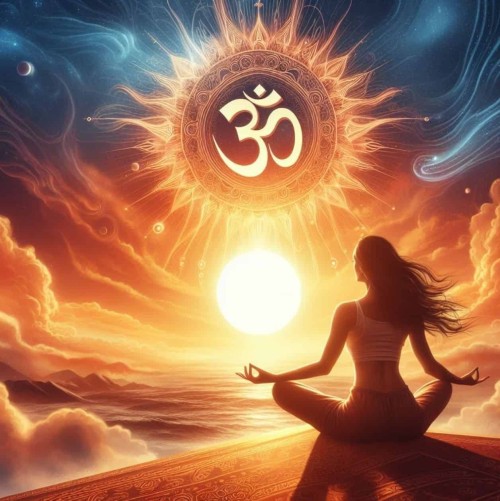In yoga, “Om” is traditionally chanted at the beginning and end of a yoga session, fostering a sense of unity with the universe and promoting inner peace.
Let’s uncover why chanting “Om” matters at the start and finish of a yoga session and how this ancient mantra profoundly influences the mind, body, and soul.
The Opening Chant – “Om”
As yoga enthusiasts unfold their mats and assume a serene seated posture, the enchanting sound of “Om” reverberates through the space.
This three-syllable mantra, comprised of A-U-M, symbolizes the unity of waking, dreaming, and deep sleep states.
Chanting “Om” at the start of a session harmonizes the self, fostering an immediate connection between the individual and the universal energies.

The vibrations of “Om” guide practitioners into a focused state of awareness, shedding external distractions and paving the way for a centred practice.
This ancient sound, often called the “sound of the universe,” is believed to activate the chakras, promoting balance and alignment within the energetic body.
As practitioners synchronize their breath with the rhythmic chanting of “Om,” they establish a link between the physical and the metaphysical, setting the stage for a transformative yoga experience.
Exploring the Essence of “Om”
Beyond its phonetic simplicity, “Om” encapsulates profound philosophical concepts.
The “A” sound represents the waking state, signifying creation and the beginning.
The “U” sound symbolizes the dreaming state, representing preservation and continuity.
Lastly, the “M” sound means the deep sleep state, denoting dissolution and the end.
The silence that follows the audible chant represents the transcendent state, the ultimate reality beyond the manifest world.

The Closing Chant – “Om”
As the final moments of the yoga journey unfold, participants converge in a collective meditation, culminating in the rhythmic chanting of “Om.”
This repetition creates a powerful vibrational wave that resonates within each practitioner, grounding them in the serenity cultivated during their practice.
The universal resonance of “Om” is a harmonious conclusion, echoing the journey towards inner peace and wholeness.
During this concluding chant, the vibrations of “Om” are believed to cleanse and purify the energy field surrounding the practitioners.
It acts as a sonic reset, washing away any lingering tension or stress and leaving a sense of tranquillity and rejuvenation.
As individuals share in the collective vibration of “Om,” a feeling of unity and interconnectedness permeates the space, creating a community of energy and intention.
Understanding the Power of Sound
Chanting mantras in yoga is deeply rooted in the ancient practice of Nada Yoga, where sound becomes a conduit for spiritual awakening. Scientifically, chanting stimulates the vagus nerve, promoting relaxation and reducing stress levels.
Beyond the physical benefits, the rhythmic cadence aids concentration, enhancing the meditative experience within the yoga space.
The repetitive nature of chanting “Om” induces a meditative state, allowing practitioners to enter a state of deep relaxation.
As the vibrations of “Om” resonate within the body, they create a sense of inner calm and focus, helping to quiet the fluctuations of the mind.
This harmonizing effect extends beyond the physical practice, influencing the mental and emotional well-being of the practitioner.

Customizing Chants for Personal Practice
While “Om” is a universal embrace, yoga offers various mantras for practitioners to explore based on personal preferences and spiritual inclinations.
Some may resonate with the enlightening “Gayatri Mantra,” invoking the divine light for guidance and wisdom.
Others may choose the expansive “Lokah Samastah Sukhino Bhavantu” mantra, extending wishes of well-being to themselves and all beings.
The flexibility to customize chants allows individuals to personalize their yoga practice, creating a sacred space that aligns with their unique spiritual journey.
This inclusivity reflects the essence of yoga as a personal and transformative practice, inviting practitioners to explore and integrate various mantras that resonate with their hearts.
Conclusion
In the symphony of yoga, “Om” is the timeless overture and the serene coda, weaving a seamless thread through the fabric of each practitioner’s journey.
The tradition of chanting “Om” at the beginning and end of a yoga session invites individuals to delve into a universal language of unity, peace, and self-discovery.
As the echoes of “Om” linger in the air, practitioners find themselves encapsulated in the transformative embrace of a practice that transcends time and culture.
The rhythmic vibrations of “Om” echo the universe’s heartbeat, leaving an indelible mark on the heart and soul.
The journey towards inner peace and wholeness continues, guided by the timeless sound that resonates within, offering a harmonious bookend to every yoga journey.

